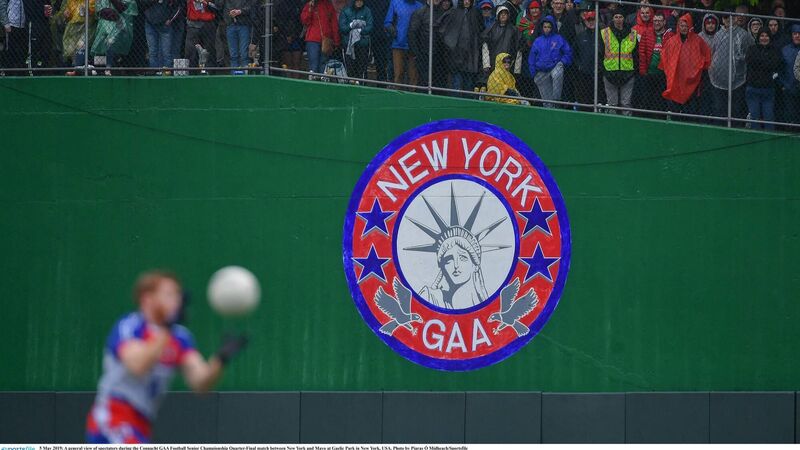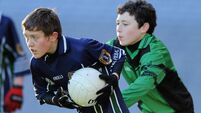John Riordan: What a New York win would mean to the Irish diaspora of Woodlawn

NEW YORK WELCOME: A general view of spectators during the Connacht GAA Football Senior Championship Quarter-Final match between New York and Mayo at Gaelic Park in 2019. Pic: Piaras Ó Mídheach/Sportsfile
Last week in Manhattan's West Village, I had the pleasure of spending a few early evening hours with two generations of an Irish-American family from Woodlawn in the Bronx.
The expansive diaspora flung over to America since before the Declaration of Independence has spun out all sorts of complexity, good and bad. We can’t be proud of everything the Irish have offered America and it’s more appropriate to be critical of the sins of the past and of the present.
But often you’ll meet the good ones who enjoy that happy combination of fealty to the traditions they grew up with allied with a keen sense of justice engendered by Ireland’s underdog status. In other words, some of them didn’t pull up the ladder behind them and turn against their fellow immigrants.
Since I've moved here, Woodlawn has been a source of fascination and often, admittedly, a little cynicism. It is a pocket of distilled Irishness, the main thoroughfare of which serves as the border between New York City and the adjoining county of Westchester. McLean Avenue is a gateway to Yonkers, to upstate New York, to prosperity in the suburbs and beyond.
It’s a hub of socialising and once you’re done wringing it dry, whether you’re a J1er or a young GAA player cashing in on construction or bartending or, to a less profitable extent, nursing or nannying, you venture out to Rockland County or Orange County to settle down. Or you go back to Ireland, as was common during the boom years of the Celtic Tiger.
One of the big days for getting back down to the Bronx happens this weekend, the annual visit of the Connacht Senior Football Championship to Gaelic Park, a ten-minute drive from McLean Avenue where everyone will end up again after Saturday evening’s full-time whistle.
Woodlawn is unrecognisable from when the Irish first started to migrate there from elsewhere in the Bronx and Upper Manhattan in the 1950s and 60s. It was fascinating to hear from these three siblings born and raised in Woodlawn before it was Woodlawn.
Their Cavan-born mother had immigrated to the States from post-war Belfast, following the example of her sister who confirmed the promise of the New World. Now 94, she was then and still is now a committed pioneer and was keen to find a husband who was similarly minded.
These two rare Irish people discovered each other at a Midtown Manhattan dance tailored specifically for young people committed away from the demon drink. It was the mid 1950s by now and they started a family and pretty soon made the move north from Fordham Heights to Woodlawn.
As with so many areas across New York City and other major cities, it was a fear of the other and the resultant waves of white flight which sent the Irish to the furthest reaches of the Bronx at a time of great change and civil unrest.
Ironically, when they started to populate the new neighbourhood, the script was reversed and they were subject to their own cycle of discrimination, shunned by the traditionally German-American locals for being Irish and Catholic.
But soon enough, through sheer force of will as well as the heavy advantage of Irish influence flowing through multiple levels of city structures, not to mention the traditional commitment to Olympic levels of reproduction, Woodlawn became an entirely Irish neighbourhood.
These siblings gave me a new insight into Woodlawn that perhaps I've been too reluctant to find out about. They reminisced fondly on the community their parents were building there; their block alone had 90 children growing up and running around freely and chaotically.
Back then, there wasn’t a pub on every corner and so there wasn’t a J1er throwing up in a hedge or sleeping it off by a traffic light. They had 90 eager friends, 90 willing accomplices and 90 ready allies, the population explosion was a boon for unforgettable adventures.
The brother of these three siblings had grown up playing Gaelic Football for Fordham Celtics, his father keeping him rooted with their first home 20 minutes down the road.
He even got to travel with his minor team to Offaly and Kerry to take on local sides there, a trip of a lifetime in the mid 70s, kitted out in the colours of their native city but retracing their roots in Ireland thanks to the unique draw of the GAA.
Meanwhile, this new parish of St. Barnabas was, as it is now, a hotbed for developing young football talent and several of the players involved in the panel for the visit of Leitrim developed their skills as Barnabas boys.
The St Barnabas club, indeed, famously achieved the feat of being the first American-born team to win the New York county championship almost three years ago in a runoff that was delayed by the pandemic and given special meaning by the fact that all senior football players taking part that season were “home based” due to the travel ban.
The influx of mass immigration in the 80s buffered by the Morrison Visa opportunities of the early 90s transformed Woodlawn irreversibly but the New York born natives navigating adulthood at that time welcomed their new Irish neighbours with open arms.
And the GAA became their surprisingly common thread, a rite of youthful passage for the Irish-Americans and a vital connection to home for the economic immigrants forced to abandon their clubs back home.
Last week, we discussed the game against Leitrim as much as we could.
It’s a sort of intangible tradition which feels a little mysterious, especially for native New Yorkers who learned the game when Gaelic Park was an unplayable dust bowl, long before astro turf was laid down ahead of the near defeat of Galway in 2010.
How do you explain it to someone who isn’t Irish? I’ve often tried. Even for the ones who grew up steeped in their version of Irishness and in how football defined their youth, the slightly newer annual tradition of the Irish team coming over to beat New York seems probably more akin to a sideshow of Harlem Globetrotters proportions.
We were all low on detail, the game happens then it passes. And the real Bronx business of baseball takes over as Springtime moves forward.
But here we are again with another round of heightened expectations and nobody knows why. Leitrim are rightly odds on favourites with a solid Division 4 campaign far outweighing anything New York manager Johnny McGeeney could even dream about providing to his players.
New York will be prepared as well as they possibly can be but it’s the perennial caveat on this side of the water that no training session could ever match an hour or so of full-blooded football.
A challenge game last Saturday between their A and B teams went the way of the second 15 and was seen as a timely positive, in spite of a couple of knocks picked up along the way.
I’ve spoken to three people from the New York camp and they are convinced they have a real shot here. Of course, none of that is on the record and as of writing, my chances of getting quotes for a Saturday preview are looking stark.
They don’t want to talk and I don’t blame them. Leitrim won’t know enough about the foe they’re flying in to take on and they couldn’t possibly.
The Connacht opener is rightfully in the shadow of every other championship game throwing in this weekend and it’s not even close to being the province’s biggest game of the weekend.
Even in the pre-pandemic days when they owned the first weekend in May, New York could barely muster up the energy to demand being taken seriously back home.
But since we are in that sweet spot before a ball has been kicked in anger and since the visitors are the weakest of the options available, the unprecedented scenario of a trip to Connacht for an unexpected semi-final remains a possibility.
Last year, Sligo delayed things until the final ten minutes when they choked the life out of the contest. We’re in unchartered territory on Saturday with a new throw-in time of 6pm which will allow for a keen viewership in bars across Leitrim as closing time approaches.
What this match means for the Irish of Woodlawn, Westchester, Rockland, Queens, Connecticut and elsewhere is the lifeblood of familiarity.
What a win would mean for the players, management and County Board who worked their way through a dreary winter to get to this point is immeasurable.








